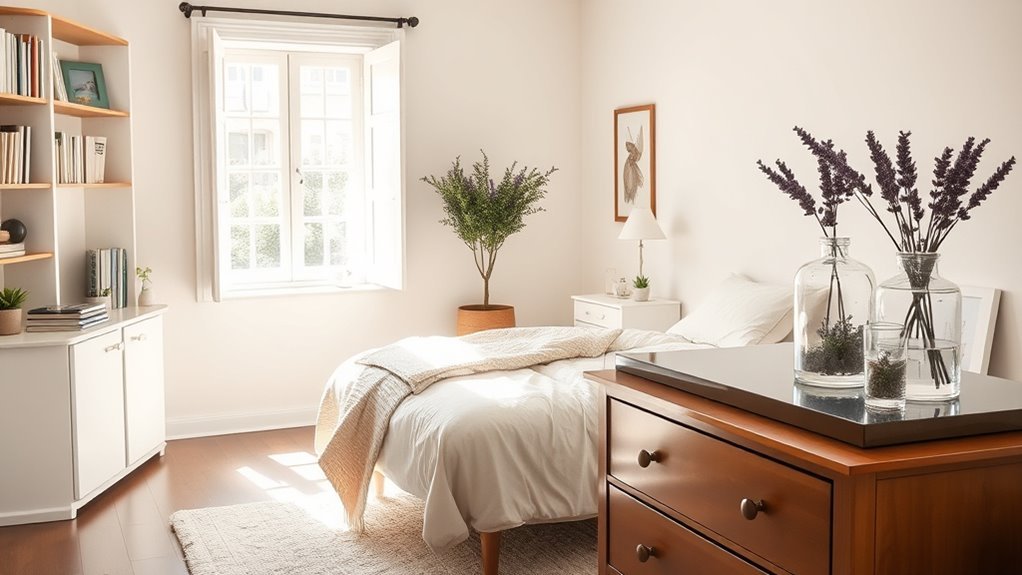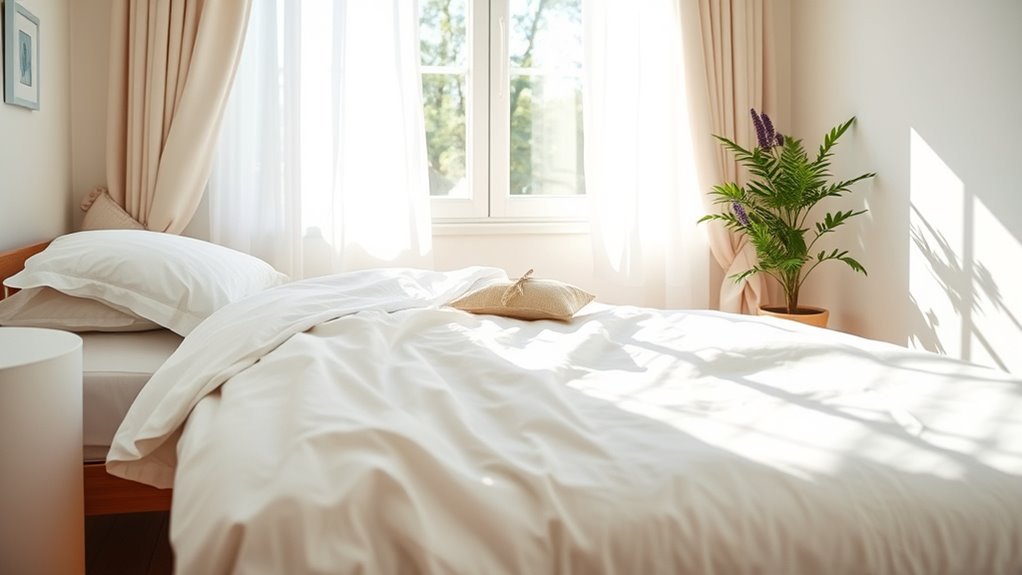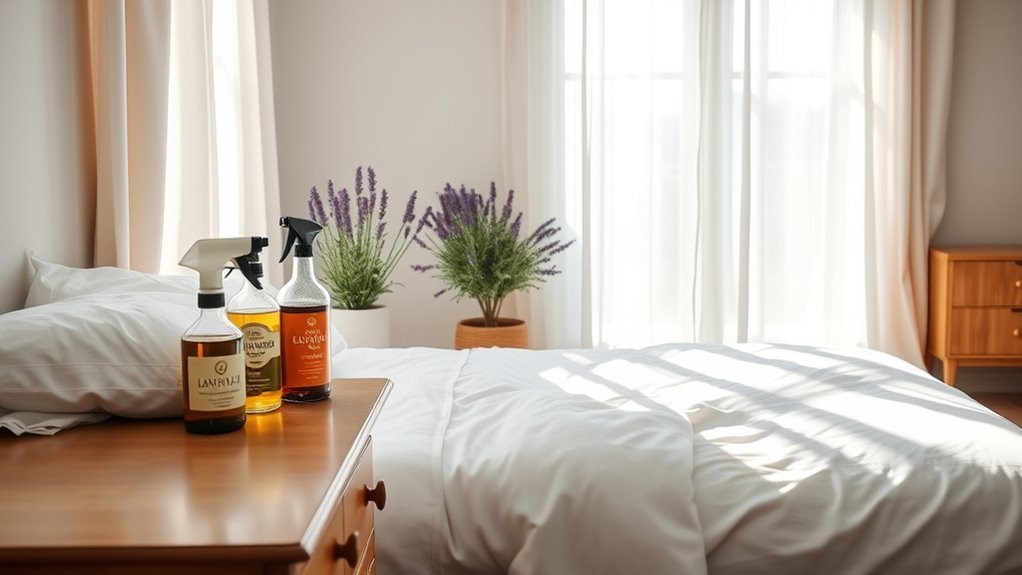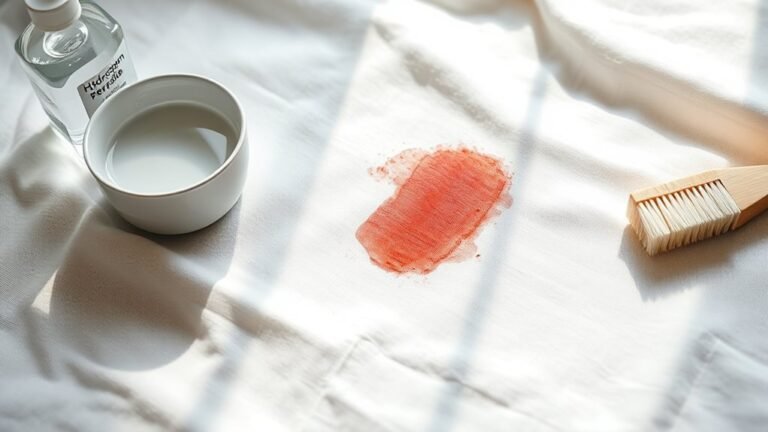How to Clean and Deodorize Your Bedroom
Start by decluttering your bedroom, sorting items into keep, donate, and discard piles to create a calm space. Dust all surfaces from top to bottom using microfiber cloths, and wash bedding, curtains, and upholstery as per care instructions. Vacuum floors and clean closets for thorough freshness. Freshen air with plants or essential oils, and keep windows open daily for ventilation. Stick to a cleaning routine to maintain order. You’ll find even more ways to keep your bedroom fresh and inviting.
Declutter Your Bedroom Space

Before you begin cleaning, it’s essential to declutter your bedroom space to create a clear, organized environment. Start by sorting items into three categories: keep, donate, and discard. Embrace a minimalist approach—focus on essentials that bring you joy or serve a purpose. Use organizational tools like labeled bins, drawer dividers, and wall hooks to keep belongings neatly stored and accessible. Clear surfaces first, such as nightstands and dressers, then move to the floor and closet. When deciding what to keep, ask yourself if each item supports your sense of freedom and calm. This methodical process not only frees physical space but also clears mental clutter, setting the stage for a fresh, serene bedroom ready for thorough cleaning and deodorizing.
Dust All Surfaces Thoroughly
Once you’ve cleared the clutter, you’ll want to dust all surfaces thoroughly to remove accumulated dirt and allergens. Start at the highest points, like ceiling fans and shelves, and work your way down to prevent dust from resettling on cleaned areas. Use appropriate cleaning tools—microfiber cloths are ideal for trapping dust without spreading it around. Avoid dry dusting, which only redistributes particles. For delicate objects or electronics, use soft brushes or compressed air. Don’t forget hidden spots: window sills, baseboards, and vents often harbor dust. Move furniture slightly to reach underneath and behind. Surface dusting not only improves air quality but also refreshes your space, making it feel freer and more inviting. Stay methodical and patient—you’ll enjoy the fresh clarity once you’re done.
Wash Bedding and Curtains

Refresh your bedroom by washing your bedding and curtains regularly to eliminate dust, allergens, and odors that accumulate over time. Start by checking the fabric care labels to choose the right water temperature and detergent, preserving the integrity of your fabrics. Separate bedding and curtains by color and fabric type to avoid damage. Use a detergent designed for odor removal to guarantee freshness. For heavily soiled items, add a cup of white vinegar during the rinse cycle to neutralize lingering smells. When washing curtains, consider a gentle cycle to prevent wear. After washing, dry bedding and curtains thoroughly to prevent mildew. This routine not only keeps your fabrics clean but also creates a breathable, odor-free space, letting you enjoy the freedom of a fresh and inviting bedroom environment.
Vacuum Floors and Carpets
Start by adjusting your vacuum cleaner to the correct setting for your floor type to guarantee effective dirt removal. Pay special attention to high-traffic areas where dust and debris tend to accumulate more. Move the vacuum slowly and methodically to capture all particles and refresh your bedroom’s air.
Choose Appropriate Vacuum Settings
Selecting the right vacuum setting is essential for effectively cleaning your floors and carpets without causing damage. Start by adjusting your vacuum’s height to match the surface: higher for hard floors, lower for carpets to maximize suction. Use vacuum attachments to reach corners and tackle pet hair. If your vacuum offers suction control, reduce it on delicate surfaces to avoid scattering debris.
| Surface Type | Recommended Setting |
|---|---|
| Hard Floors | Higher height, moderate suction |
| Low-Pile Carpet | Low height, high suction |
| Pet Hair Areas | Use brush attachment, high suction |
Focus on High-Traffic Areas
Because high-traffic areas accumulate more dirt, dust, and allergens, you’ll want to prioritize vacuuming these spots thoroughly. Start by identifying high traffic hotspots such as entryways, pathways between furniture, and near your bed. These frequent cleaning areas demand your focus to maintain a fresh, breathable environment. Use slow, deliberate strokes with your vacuum to lift embedded debris from carpets and floors. Don’t forget to adjust your vacuum settings for carpet thickness to maximize dirt removal. Pay attention to edges and corners where dust tends to settle unnoticed. By routinely targeting these zones, you reduce allergens and keep your bedroom feeling open and free. This methodical approach guarantees your vacuuming is efficient, freeing you to enjoy a cleaner space without wasted effort.
Clean and Organize Closets

Start by sorting through your closet, separating items to keep, donate, or discard. Use bins, shelves, and hangers to create an efficient storage system that maximizes space. Finally, set a schedule to regularly tidy and reassess your closet to maintain order and freshness.
Declutter and Sort
Begin by emptying your closet completely to get a clear view of all the items you have. Lay everything out so you can assess each piece without distraction. As you sort, categorize your belongings into groups—keep, donate, and discard. Be honest with yourself; if you haven’t worn or used something in the past year, it’s time to discard unused items. This step is essential to freeing up space and simplifying your life. Next, organize belongings by type and frequency of use, placing everyday items within easy reach. This methodical approach helps you reclaim control over your space, making it easier to maintain cleanliness and order. By decluttering thoughtfully, you create a bedroom environment that promotes relaxation and freedom from chaos.
Use Storage Solutions
Once you’ve decluttered your closet, it’s important to implement storage solutions that maximize space and keep your items organized. Using storage bins for smaller items and seasonal clothes helps you free up shelf space. Don’t forget under bed storage; it’s perfect for shoes or extra bedding, keeping your floor clear. Here’s a simple plan to optimize your closet:
| Storage Type | Best For | Placement |
|---|---|---|
| Storage Bins | Accessories, Socks | Shelves, Floor |
| Hanging Organizers | Scarves, Belts | Closet Rod |
| Under Bed Storage | Shoes, Extra Linens | Under Bed |
| Drawer Dividers | Small Clothing | Drawers |
| Clear Containers | Seasonal Clothing | Top Shelves |
This methodical setup lets you maintain freedom in your space and find what you need effortlessly.
Maintain Regularly
Regularly cleaning and organizing your closet guarantees it stays functional and clutter-free, preventing messes from piling up. To maintain this, set a consistent cleanliness schedule—weekly or biweekly works well. Start by removing items that no longer fit or suit your style to free up space. Then, neatly arrange remaining clothes by category or color, making it easier to find what you need. Incorporate quick daily bedroom habits like hanging clothes immediately or putting shoes away to avoid buildup. Use labeled bins or shelves for accessories to keep everything in its place. By sticking to these routines, you’ll create a closet that supports your lifestyle, giving you freedom from clutter and stress while maintaining a serene, organized bedroom environment.
Use Natural Deodorizers
Although commercial air fresheners might seem convenient, using natural deodorizers is a healthier and more effective way to keep your bedroom smelling fresh. You can start by sprinkling baking soda on carpets or rugs; let it sit for 15–30 minutes before vacuuming to absorb odors. Next, create a simple spray by mixing water with a few drops of your favorite essential oils—like lavender or eucalyptus—and lightly mist your room. You can also place bowls of white vinegar in corners overnight to neutralize smells. Finally, consider hanging dried herbs or sachets filled with dried lavender or cedar chips to release subtle, natural scents. These methods give you control over what fills your space, promoting a clean, fresh environment without harsh chemicals.
Eliminate Odors From Upholstery
Dealing with odors trapped in upholstery requires targeted cleaning techniques to refresh your furniture effectively. Start by vacuuming thoroughly to remove dust and debris. Next, apply fabric fresheners designed for upholstery, allowing them to neutralize lingering smells. For deeper cleansing, steam cleaning is highly effective; it penetrates fibers, killing bacteria causing odors.
| Step | Tool/Method |
|---|---|
| Vacuum upholstery | Vacuum cleaner |
| Apply freshener | Fabric fresheners |
| Steam clean | Steam cleaner device |
| Dry thoroughly | Air drying or fan |
Be methodical: vacuum first, spray fabric fresheners evenly, then steam clean. Ascertain upholstery dries completely to prevent mildew. This routine revives your furniture’s freshness, giving your bedroom a cleaner, more liberating atmosphere.
Freshen the Air With Plants or Essential Oils
When you want to maintain a consistently fresh atmosphere in your bedroom, incorporating plants or essential oils can be a simple yet effective solution. Start by selecting aromatic plants like lavender or eucalyptus, known for their natural air-purifying qualities. Next, choose essential oil blends tailored to your preference—citrus or minty scents instantly uplift the space. Place plants strategically near windows or vents for ideal airflow. Use a diffuser for essential oils, running it intermittently to avoid overwhelming the room. Here’s how to get started:
Incorporate aromatic plants and essential oils for a naturally fresh and inviting bedroom atmosphere.
- Pick low-maintenance aromatic plants suited to your light conditions
- Use high-quality essential oil blends for long-lasting fragrance
- Position plants where they can thrive and enhance air quality
- Operate diffusers in cycles to maintain a balanced scent level
These steps help you enjoy a fresher, more inviting bedroom environment.
Maintain Proper Ventilation
To maintain proper ventilation, make sure you open your bedroom windows daily to allow fresh air to circulate. Use fans or air circulators to keep the airflow steady and prevent stagnant air. Also, keep an eye out for any dampness buildup, as moisture can lead to odors and mold.
Open Windows Daily
Although it might seem simple, opening your bedroom windows daily plays an essential role in maintaining proper ventilation and ensuring fresh air circulates throughout the space. Incorporating this into your daily routine helps remove stale odors and reduces indoor pollutants, creating a healthier environment. To do this effectively:
- Open windows for at least 10-15 minutes each day to maximize fresh air exchange.
- Choose times when outdoor air quality is best, usually mid-morning or early afternoon.
- Secure screens to prevent insects from entering while keeping windows open.
- Adjust window openings to control airflow without causing drafts that disrupt comfort.
Use Air Circulators
Opening your windows is a great start to improving airflow, but you can enhance ventilation further by using air circulators. To boost air quality effectively, position fans strategically rather than randomly. Place one fan near a window, facing outward, to push stale air outside. Use another fan inside, facing inward, to pull fresh air in. This setup creates a cross-ventilation effect, accelerating air exchange. Make certain fans aren’t obstructed by furniture or curtains, which can reduce efficiency. Adjustable fan speeds allow you to control airflow according to your needs, maintaining comfort without sacrificing ventilation. By methodically arranging your air circulators, you’ll guarantee continuous fresh air movement—helping you reclaim your bedroom’s atmosphere and enjoy a freer, cleaner space every day.
Avoid Dampness Build-up
Because moisture can quickly accumulate in your bedroom, it’s essential to maintain proper ventilation to avoid dampness build-up. Effective dampness prevention hinges on controlling moisture absorption and allowing fresh air to circulate freely. Here’s how you can do it:
- Open windows daily to let humid air escape and invite fresh air in.
- Use exhaust fans, especially after showering, to reduce indoor moisture levels.
- Place moisture absorbers like silica gel or activated charcoal in corners prone to dampness.
- Avoid drying clothes indoors, as this adds excess moisture to the air.
Establish a Regular Cleaning Routine
Creating a consistent cleaning schedule is essential for maintaining a fresh and inviting bedroom. Start by designing a cleaning checklist that breaks down tasks into daily, weekly, and monthly categories. For daily tasks, focus on simple actions like making your bed, tidying surfaces, and ventilating the room to prevent stale air. This routine keeps clutter at bay and sets a positive tone for the day. Weekly tasks should include dusting furniture, vacuuming floors, and washing bedding, while monthly chores might involve deep cleaning carpets or curtains. Stick to your checklist to avoid feeling overwhelmed and to enjoy a cleaner, more comfortable space. By establishing this disciplined routine, you free up mental space and create an environment that supports relaxation and freedom.
Frequently Asked Questions
How Often Should I Replace My Mattress to Avoid Odors?
You should replace your mattress roughly every 7 to 10 years to maintain odor prevention and overall freshness. Over time, mattresses accumulate sweat, dust mites, and allergens that cause unpleasant smells. To extend your mattress lifespan, use a protective cover and regularly clean bedding. If you notice persistent odors despite cleaning, it’s a sign to upgrade. Staying proactive guarantees your bedroom stays free from unwanted smells, helping you breathe easy and sleep freely.
Can Certain Paint Colors Affect Bedroom Freshness?
Did you know that 62% of people feel more relaxed in rooms painted blue? When choosing paint colors, understanding paint psychology helps you select hues that promote vitality and calm. Cool colors like blue or green can make your bedroom feel airy and clean, while warm colors might trap heat and odor. So, methodically pick shades that enhance your space’s vibe and keep the atmosphere invigorating, giving you freedom to rest easy.
Do Air Purifiers Help in Reducing Bedroom Odors?
Yes, air purifiers can greatly improve your bedroom’s air quality and aid in odor elimination. You’ll want to choose a purifier with a HEPA filter and activated carbon, as these target both particles and smells. Place it near common odor sources and run it consistently to capture allergens and neutralize odors. This methodical approach lets you breathe freely and enjoy a fresher, cleaner space without relying solely on masking scents.
What Fabrics Trap Odors the Most in a Bedroom?
Imagine your bedroom as a garden where fabrics are the soil, some absorbing scents like thirsty plants. Through fabrics analysis, you’ll find that heavier, dense materials like wool, velvet, and polyester trap odor sources more stubbornly than cotton or linen. To free your space, focus on these culprits: regularly airing out and washing them breaks the cycle, letting fresh air bloom and liberating your room from hidden smells.
Are There Specific Cleaning Tools Best for Delicate Bedroom Surfaces?
When tackling delicate surfaces, you’ll want to choose gentle cleaning tools like microfiber cloths and soft-bristle brushes. These help avoid scratches while effectively lifting dust. Use cleaning techniques that involve light dabbing rather than harsh scrubbing, and always test a small area first. Avoid abrasive sponges or strong chemicals, which can damage finishes. By being methodical and patient, you maintain your bedroom’s freedom from damage and keep it looking fresh and cared for.






